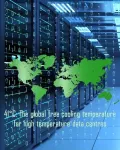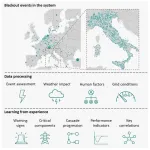(Press-News.org) Colder is not always better for energy-hungry data centers, especially when it comes to their power bills. A new analysis says that keeping the centers at 41°C, or around 105°F, could save up to 56% in cooling costs worldwide. The study, publishing October 10 in the journal Cell Reports Physical Science, proposes new temperature guidelines that may help develop and manage more efficient data centers and IT servers in the future.
“The cooling system accounts for over one-third of the data center’s total energy consumption, so many studies talk about reducing the energy consumption of cooling systems,” says senior author Shengwei Wang of the Hong Kong Polytechnic University. “But rather than finding better ways to cool the data centers, why not redesign the servers to operate at higher temperatures?”
Data centers typically operate at temperatures between 20–25°C (68–77°F) today. The conventional cooling systems that maintain these centers work by pulling computer-generated hot air past water-chilled coils to cool down the air before it cycles back to the space. The heated water then enters either chillers or a process called free-cooling before circulating back to the coils. Unlike energy-intensive chillers that operate similarly to air conditioners, free-cooling uses ambient air to cool the water with much less energy use.
To save energy, data centers are often built in colder areas to leverage free-cooling. But thanks to advances in electronic technology, engineers and scientists know that it’s no longer necessary to blast the chiller-based air conditioning at data centers. Many IT servers already allow a higher temperature operation above 30°C (86°F). This means that in most climates, including those that are hotter, data centers can also benefit from free-cooling by raising the temperature of data centers.
“The question is, to what temperature?” says Wang. To find out, Wang and his team built a model based on the conventional cooling system and simulated the system’s operation under different climate conditions. The results showed that data centers in almost all regions across climate zones could rely nearly 100% on free-cooling throughout the year when operated at 41°C, which they coined “global free-cooling temperature.” These data centers could save 13%–56% of energy compared to those that run at 22°C (71.6°F).
Depending on an area’s temperature and humidity, the researchers say that data centers might not even need to raise the temperature that far to take full advantage of free-cooling. For example, the temperatures for Beijing, Kunming, and Hong Kong to entirely rely on free-cooling are 39°C (102.2°F), 38°C (100.4°F), and 40°C (104°F), respectively.
“But before we raise the temperature settings, we need to ensure three things,” says Wang. “First, we need to ensure the reliability of server operation. Second, the computational efficiency needs to remain the same. Third, we need to ensure the servers’ energy consumption is not increased by activating their built-in cooling protection, such as the fans.” That said, Wang is optimistic that it is possible for the next generation of servers to work at up to 40°C without performance degradation.
“For the first time we can provide cooling system engineers and server design engineers a concrete goal to work towards,” says Wang. “I think 41°C is achievable in the near future. We’re only 10°C (18°F) or less away.”
###
This work was supported by a collaborative research fund (C5018-20G) and a grant under the Hong Kong PhD Fellowship Scheme of the Research Grants Council in the Hong Kong SAR.
Cell Reports Physical Science, Wang et al. “The global energy impact of raising the space temperature for high-temperature data centers.” https://www.cell.com/cell-reports-physical-science/fulltext/S2666-3864(23)00444-7
Cell Reports Physical Science (@CellRepPhysSci), published by Cell Press, is a broad-scope, open access journal that publishes cutting-edge research across the spectrum of the physical sciences, including chemistry, physics, materials science, energy science, engineering, and related interdisciplinary work. Visit: https://www.cell.com/cell-reports-physical-science/home. To receive Cell Press media alerts, please contact press@cell.com.
END
Power grids—the web of electrical networks that sprawl across countries and continents—are under stress. Extreme weather events and volatile energy demands often push the system to the brink. Although these high-impact events can be very damaging, often overlooked is the impact of minor disruptions that trigger a domino effect throughout the system, according to a study analyzing European power blackouts. The findings, published October 18 in the journal Joule, showed that recovering power within 13 hours can reduce up to ...
Starting buprenorphine treatment for opioid use disorder through telehealth was associated with an increased likelihood of staying in treatment longer compared to starting treatment in a non-telehealth setting, according to a new study analyzing Medicaid data from 2019-2020 in Kentucky and Ohio. Published in JAMA Network Open, these findings add to a growing body of evidence demonstrating positive outcomes associated with the use of telemedicine for treatment of opioid use disorder.
In Kentucky, 48% of those who started buprenorphine treatment via telehealth remained in treatment for 90 continuous days, compared ...
In a first-in-human phase 1 trial in 41 patients with recurrent glioblastoma, an oncolytic virus treatment designed by Brigham researchers extended survival, especially among those with pre-existing viral antibodies
Therapy turns ‘immune desert’ into inflammatory cancer-fighting zone
Study demonstrated the safety and preliminary efficacy of a novel gene therapy for glioblastoma
Glioblastoma (GBM), an aggressive brain cancer, is notoriously resistant to treatment, with recurrent GBM associated with survival of less than 10 months. Immunotherapies, ...
Ordinary pencil lead holds extraordinary properties when shaved down to layers as thin as an atom. A single, atom-thin sheet of graphite, known as graphene, is just a tiny fraction of the width of a human hair. Under a microscope, the material resembles a chicken-wire of carbon atoms linked in a hexagonal lattice.
Despite its waif-like proportions, scientists have found over the years that graphene is exceptionally strong. And when the material is stacked and twisted in specific contortions, it can take on surprising electronic behavior.
Now, MIT physicists have discovered another surprising property ...
About The Study: The results of this meta-analysis of 40 studies including 310,000 children and adolescents suggest that, in general, the treatment rates for mental disorders among children and adolescents were low, especially for depression and anxiety. Targeted intervention policies and effective measures should be designed and implemented to improve treatment rates of psychiatric disorders among youths.
Authors: Yuanyuan Xiao, Ph.D., of Kunming Medical University in Kunming, Yunnan, China, is the corresponding author.
To access the embargoed study: Visit our For The Media website at this link https://media.jamanetwork.com/
(doi:10.1001/jamanetworkopen.2023.38174)
Editor’s ...
About The Study: The findings of this study including 340,000 pregnant women suggest that long-term exposure to antepartum and postpartum air pollution was associated with higher postpartum depression risks. Identifying the modifiable environmental risk factors and developing interventions are important public health issues to improve maternal mental health and alleviate the disease burden of postpartum depression.
Authors: Jun Wu, Ph.D., of the University of California, Irvine, is the corresponding author.
To access the embargoed study: Visit our For The Media website at this link ...
A microscopic discovery will not only enable scientists to understand the microbial world around us but could also provide a new way to control CRISPR-Cas biotechnologies.
An international team of researchers led by Professor Peter Fineran from the University of Otago and Dr Rafael Pinilla-Redondo from the University of Copenhagen has published a study in the prestigious journal Nature revealing new way viruses suppress the CRISPR-Cas immune systems of bacteria.
Co-first author Dr David Mayo-Muñoz, of the Phage-host interactions (Phi) laboratory in ...
DURHAM, N.C. – A vaccine designed to protect against three different deadly coronaviruses shows success in mouse studies, demonstrating the viability of a pan-coronavirus vaccine developed by researchers at the Duke Human Vaccine Institute.
Publishing in the journal Cell Reports, the single nanoparticle vaccine included components of a previous vaccine that was shown to protect mice and primates against multiple variants of SARS-CoV-2, which is the virus that causes COVID-19. In this study, the vaccine protected mice from SARS-CoV-1, another form of SARS coronavirus that can infect humans, and a MERS coronavirus that has led to periodic, deadly outbreaks ...
Particle accelerators are crucial tools in a wide variety of areas in industry, research and the medical sector. The space these machines require ranges from a few square meters to large research centers. Using lasers to accelerate electrons within a photonic nanostructure constitutes a microscopic alternative with the potential of generating significantly lower costs and making devices considerably less bulky. Until now, no substantial energy gains were demonstrated. In other words, it has not been shown that electrons really have increased in speed significantly. A team of laser physicists at Friedrich-Alexander-Universität Erlangen-Nürnberg ...
A new Corewell Health study suggests that men who have longer prostatic urethras, the part of the urethra that travels through the prostate, may be at a higher risk of experiencing moderate, often chronic urinary side effects after receiving radiation for prostate cancer.
To date, researchers have struggled to determine any risk factors that could shed light on who might experience these types of side effects ahead of time. But now, a simple MRI scan and a new metric to determine urethra length could change that.
Results, now published in the journal Academic Radiology, indicate that for every 1-centimeter increase in length of the prostatic ...



